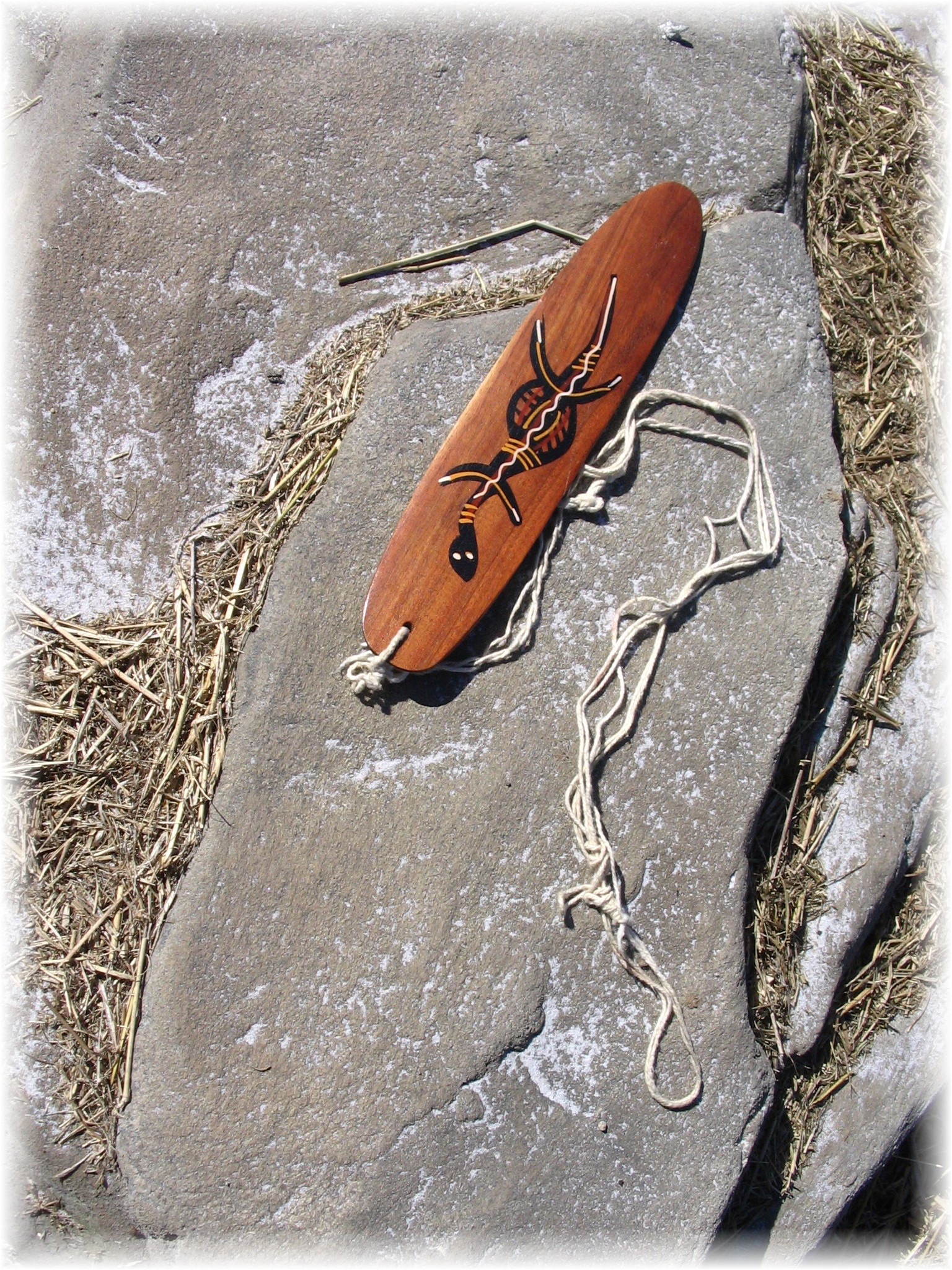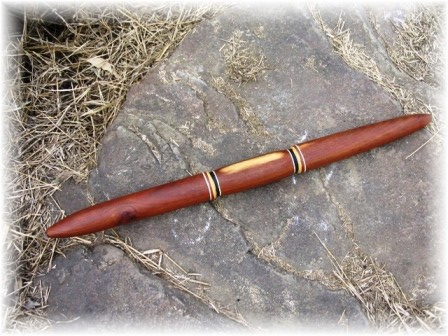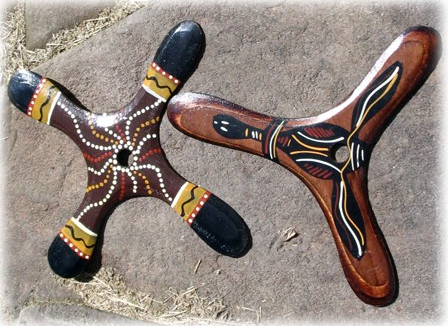A Nulla-nulla is one of the tools that both men and woman use. It is used as a club to knock out small animals. It is also a very helpful tool to crush ochre (for paint), and seeds (food preparation). It is usually made from the part where a branch meets the tree. The large part is shaped from where the wood is bigger at the join of the tree.
Coolamon 
A coolamon is a wooden bowl used to hold and carry different items. Girls learn to balance this on their head to hold honey, seeds, fruit and berries when collecting food. It is also helpful when carrying small animals that the woman and children catch (snakes, goannas etc.).
A coolamon is made by stripping the outside part of a tree trunk. This is isually done on the border of tribal lands and the scar on the tree is then also marked to show territory.
Digging Stick
A digging stick is used by woman as a small spade. It is used to dig up vegetables, such as yams (sweet potato), and animals, such as witchetty grubs and honey-ants.
More men's Artefacts
Spears
Spears are used for different purposes. Some spears have barbs for fishing. These are designed so that the fish dont fall off after they have been speared. Other spears are designed with heads, in order to go straight into animals. Some spear heads have been made with different wood attached to the end. Some have sharpened rocks and bones attached. Since the coming of Europeans, Aboriginal people have used the rubbish of white people as spear heads. Broken glass has been one of their favourites, Spears do not have to be very sharp, as the speed of the weapon will penetrate through the animal or person at which it is thrown.

 Woomera
Woomera
A woomera is one traditional name for a spear thrower. Sprear throwers are very smart invention designed to lengtehen the arm of the thrower. Taller people have longer arms, so just like in the game of cricket, the taller players are usually the faster bowlers. The longer your arm, the faster and longer you can throw a spear.
It is made by carving a piece of wood to have a thin handle, and then by attaching to a point to sit in the base of the spear. The attached point is made from teeth bone, wood or stone.
 Bullroarer
Bullroarer
A bullroarer is a very sacred men's artefact. It is used at the start of some sacred 'men only' ceremonies to warn the woman and children to stay away, and also to invite the ancestral spirits to join them. The bullroarer is also used throughout the day as a signal. If it is spun throughout the day, that is a call for help both to the spirits and to other tribal members.
This artefact is made with a small piece of hardwood attached to a piece of string. The string is made from the bark of a string-bark tree. This bark is taken off in strips and soaked to make it more flexible, it is spun into a tight strip and then plaited together into strong string. The string is used for lots of other building and artefact creations.

Stone Axe
Stone axes are used to make most tools. They are made by joining a piece of wood (handle) to a sharpened stone (head). The stones are collected from water rocks that have been smoothed down naturally by the currents over thousands of years. The handle is split at the top and the stone is wedged into the split. The stone is then covered in a blue (bees wax, gum tree sap, animal fats) over a tightly woven string (stringy bark tree).
 Birri-ga
Birri-ga
A birri-ga is a double-ended fighting stick. The stick is spun around in combat against other people. The stick is used to block and then spin the other end around to hit with. Lots of time and practice is spent to develop the fast reflexes and skill needed to use this weapon.

Clapsticks
Clapsticks are carved pieces of wood used as a musical intrument. The instrument is clapped together to create a percussion beat. Each beat provides a rhythm for dancers to follow. In many dances, the feet of the performers hit the ground as the sticks are clapped. Clapsticks are used to signal a change or finish in a performance. One clapstick can also be used to hit against a didgeridoo to keep the beat. Boomerangs can also be used like clapsticks to clap together during a performance.
 Fire Sticks
Fire Sticks
Fire sticks are used to rub together to create sparks in making a fire. The end of one stick is sharpened on grinding stones and then rubbed into the groove of the other stick on the ground. This method is done by two people taking it in turns to heat up the sharpened stick by friction. The soon hot end of the stick breaks into small sparks. The sparks then fly into a handful of litter (fine pieces of bark etc.) The smoking litter then catches alight when spun around too quickly provide oxygen. The flame is very quickly then put into an earlier prepared fire bed.
The sticks need to be from only select plants (grass tree stalks) that have capabtility to heat with friction. The cover over the end is made to protect the ends from getting wet. This is made with fine bark, string and glue.
 Shields
Shields
Shields are made in many different shapes and sizes. Some shields are very big and wide and are used to block spear attacks. The shield show in the photo is a 'boreen', which is a combat shield. It is designed to be light and strong, so that it can block weapons during hand-to-hand combat. The ends of the boreen are pointed so that it can also be used to attack.
Torres Strait Island Artefacts
 Grass Skirt
Grass Skirt
A grass skirt is worn by both men and woman in the Torres Strait. Although it is known as a grass skirt it is made from fine leaves of a pandanus palm. Because the Torres Strait Islands are near the equator, no other clothes (shirts etc.) were worn on top. Being comfortable in the heat was more important than European privacy expectations.

Head Dress
Head dresses were worn by the men to make themselves look taller and more fearsome to strangers passing the islands on boats. This head-dress is made from feathers of a Torres Strait Island Pigeon.
 Koolups
Koolups
Koolups are a percussion instrument used to keep a beat during performances. Seed pods are cut in half and then connected with hand-made string.
Boomerangs
A boomerang is a custom shaped piece of wood used in everyday life. It is not a stick that comes back (very few come back). The purpose of the boomerang is to hunt animals for food or as weapons in warfare. Somtimes they are also used in a similar way to clapsticks, to keep the beat during music. They are made from hard wood - shaped, smoothed down, sometimes "fired" (to harden), then treated with a perservative and finally, painted (ceremonial ones).
Shapes differ from symmetrical to others having one side being much shorter than the other (the long side equals the throwing side which is held by the user.) Right and left handed boomerangs were made, using the same techniques on opposite sides. There are hundreds of different types of boomerangs to suit each environment (rainforests, open plaints etc.) and purpose (weight, flight etc.).
Primarily, the boomerang is used by the men for hunting animals.
There is a second use for the boomerang - fighting. It is indeed a lethal weapon in skilled hands. They certainly are not used as frisbees!
They are also used as musical instruments, to keep the beat (like clap-sticks) particularly for corroborees.
Boomerangs are individually hand crafted, no two will be exactly the same.
Please Remember - Boomerangs are weapons, not a "play" toy - all care should be used when throwing boomerangs or any other "tool of flight".
 Returning boomerang: This is the very famous curved shape. symmetrical piece of wood that comes back. This boomerang is used for hunting water birds, so that any misses will come back to dry land. This is especially helpful during colder periods.
Returning boomerang: This is the very famous curved shape. symmetrical piece of wood that comes back. This boomerang is used for hunting water birds, so that any misses will come back to dry land. This is especially helpful during colder periods.
 3/4 Boomerang: Also 'comeback' boomerangs, designed to return to the thrower. They can be designed for both left or right handed throws.
3/4 Boomerang: Also 'comeback' boomerangs, designed to return to the thrower. They can be designed for both left or right handed throws.

7/Killer: This boomerang is shaped similar to a number 7, and designed to be top heavy to split the skull of the target. The boomerang gose straight, and does not curve or comback. This is a very popular boomerang for hunting kangaroos and emus. This is also lethal during warfare.

Hunting: Hunting boomerangs are the most commonly used boomerang throughout Australia's open plains. This boomerang had a slight curve when thrown, although it does not come back. This is the perfect boomerang for hunting emus, flight birds and kangaroos.
 War-axe: The boomerang is a hand held boomerang, used during hand to hand combat. The boomerang is very sharp at the front (like an axe), but very pointy at the other end. The other end was used when the weapon was blocked. Once blocked the other end is skillfully spun around to pierce the neck of the attacker.
War-axe: The boomerang is a hand held boomerang, used during hand to hand combat. The boomerang is very sharp at the front (like an axe), but very pointy at the other end. The other end was used when the weapon was blocked. Once blocked the other end is skillfully spun around to pierce the neck of the attacker.

Sword: This boomerang is used in hand-to-hand combat, just like a sword. Accompanying the sword is a fighting-shield, used to block the opponent. This boomerang is only thrown as a last resort.
 Didgeridoos
Didgeridoos
A didgeridoo is a hollowed wooden musical instrument, it is made when termites eat through themiddle of certain types of wood. As brances fall during high winds, storms, lightning strikes or because of age; termites eat through the middle of the brance. This only works with some types of trees, because they are softer on the inside. Just as some children do not like eating the crust of their bread (because it is harder), termites also only eat through the soft part of the brance. Other tree branches are soft all of the way through so they eat the bottom out (not hollow).
After Aboriginal people collect the hollowed branch, it is then cut into several didgeridoos (depending on the length and condition of the branch). The pieces are then cleaned through the middle (a spear is good for this), then soaked in a stream to ensure the last of the creatures (termites, spiders etc.) are removed. The didgeridoo is then sanded (grinding stones or sandpaper fig leaves) to perfection and painted with traditional designs representing the owner's tribe and family totem.
Some people often think that all Aboriginal people play the didgeridoo. This instrument was only traditionally used throughout the northen regions of Australia. Not all people could play the didgeridoo in their tribe. Only special people were chosen to pass on the skill of didgeridoo playing. It is seen as a very high honour to be chosen as the group's didgeridoo player.
It has been a very traditional and passionate belief of traditional aboriginal societies that didgeridoos are only used and touched by males. Very strict punishment (including death) were administered if woman or girls were to touch a didgeridoo. To show respect for traditions, it is important that all people remember this rule even today.
 Digibone: A new invention (which girls can play), is a digibone or a tromdoo. This is a contemporary cross between a didgeridoo and a trombone. It is a two part instrument that slides to change the pitch of the instrument.
Digibone: A new invention (which girls can play), is a digibone or a tromdoo. This is a contemporary cross between a didgeridoo and a trombone. It is a two part instrument that slides to change the pitch of the instrument.